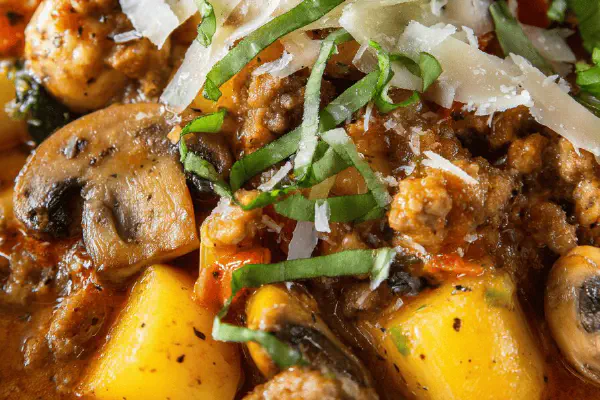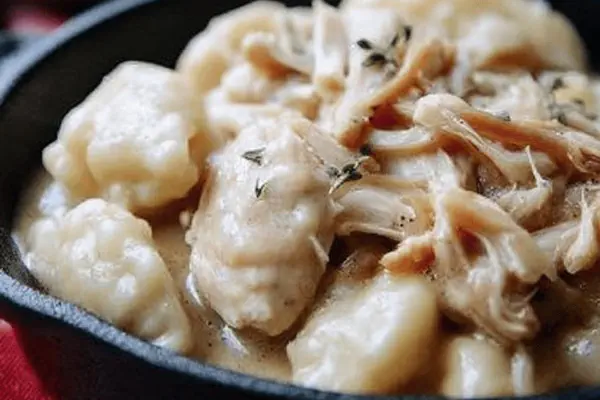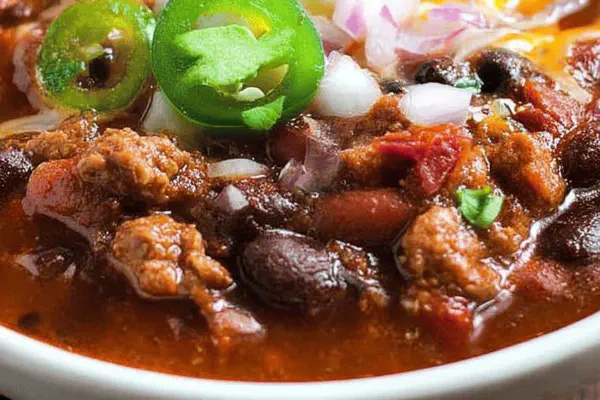Sausage Balls Veggies Slowcooked

By Emma
Certified Culinary Professional
Ingredients
- 240 g parsnips peeled cut to cubes
- 3 celery stalks sliced
- 3 yellow potatoes chopped medium
- 2 shallots finely sliced
- 225 g cremini mushrooms sliced
- 600 ml crushed tomatoes bottle
- 320 ml chicken broth concentrate undiluted
- 500 g ground pork sausage roughly 4 links worth
- Fresh basil leaves to taste
- Sharp aged cheddar shavings for topping
About the ingredients
Method
- Dump parsnips, celery, potatoes, shallots, mushrooms in slow cooker bowl. Pour crushed tomatoes plus broth. Season with salt and cracked black pepper. Stir well so all veggies below surface, cover with lid. Turn slow cooker on Low.
- Let it crawl slowly for about 7 hours 45 min. Check near 7 hour mark—veg should be tender but not falling apart. Stir gently. Aroma starts deep and sweet, earth coming through.
- Meanwhile, shape pork sausage into small, pebble-sized balls. Keep uniform for even cooking. Refrigerate until ready.
- At 7 hr 45, scatter sausage balls evenly atop veggies. Reseal lid, crank heat to High.
- Raise temp for 45 min. Listen for gentle bubbling sound and smell sausage aroma penetrating the sauce. Juice starting to thicken slightly.
- Turn off heat and let rest in closed cooker for 15 min. Sausage juices reabsorb, sauce settles.
- Spoon out chunks of veggies with sausage balls. Splash some cooking liquid for moisture. Sprinkle with fresh basil ribbons and handful of sharp cheddar shards. Serve directly in bowls.
- A quick crack of pepper on top doesn't hurt.
Cooking tips
Chef's notes
- 💡 Veggies should be just under surface in cooker bowl for even heat spread. Don’t crush or overcrowd—air and steam move flavor and texture. Check gently with spoon. Stir to test firmness but not break apart. Low setting crucial to soften roots while holding shape. Timing only a guide; smell and mild bubbling key markers.
- 💡 Sausage balls must be small, uniform size equals cooking consistency. Big means raw center, small means dryness. Form tight but not dense—air pockets slow cooking. Refrigerate pre-heat to keep shape collapsing. Add late in slow cooker cycle; sausage finishes on high briefly to keep juice inside.
- 💡 Broth concentrate controls sauce intensity—too much dilutes flavor, too little too thick. Substitute beef stock if preferred but adjust salt accordingly. Tomato crushed from bottle adds acidity and body. Fresh basil tossed late preserves brightness; dried herbs won’t work alike here.
- 💡 Shallots versus onion swap based on sweetness and texture. Shallots break down soft and add subtlety without onion harshness. If using yellow onion, slice thicker and reduce quantity. Celery replaces carrot—keep some crisp contrasts but skip if you want wholly soft roots. Mushrooms can be button if cremini not found but lose some earth depth.
- 💡 Resting stage after high heat finish is critical. Residual heat softens sausage and mingles flavors further. Could skip but you risk drying sausage or uneven texture. Juices pull back into meatballs, sauce thickens slightly but still spoonable. Basil ribbons and sharp cheddar shards sprinkled at service brighten and add textural counterpoint.
Common questions
How to know when veggies are done?
Look, poke gently. Should yield but hold shape. No mush. Smell deep and sweet, subtle earthy. Bubbling slow, not roaring. Visual check better than clock here. Stir for texture test.
Can I swap meats in balls?
Sure. Turkey sausage or Italian pork ok. Cooking times might shift. Turkey dries faster, keep balls a bit bigger and watch closely. Italian sausage adds spice, maybe adjust seasoning. Ground pork standard for fat and flavor balance.
What if sauce too thin?
After cooking, remove lid and turn high heat briefly to reduce. Sauces thin if broth high or no rest period. Rest thickens naturally. Also, adding cheese shards last time adds perceived thickness and richness.
How store leftover?
Cool quickly. Fridge in airtight for 3-4 days. Freeze flatten in bag up to 2 months. Reheat low and slow to avoid drying sausage. Add fresh basil and a little sharp cheddar again on serve after warming.



